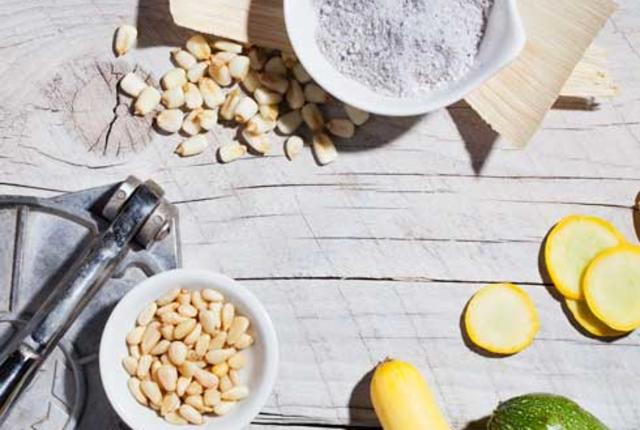Above: Piñon nuts, tortilla press, dried posole, blue cornmeal on husks, yellow squash, zucchini. Photography by Jen Judge.
I’M NOT A NATIVE New Mexican, but I eat like one. And I’m getting to the point where I’d like to cook like one as well. So it seemed a good idea to explore and share what real New Mexican cooks think are the most important elements in a New Mexican kitchen.
My first stop was a series of cookbooks produced in the 1960s by the women of the Española Hospital Auxiliary. The recipes in the hand-illustrated, photocopied, and hand-stapled booklets were divided among Indian, Hispanic, and Anglo dishes, and very useful for clueing me in on particular ingredients. I then spent some time with Janet Malcolm, chef and manager of the famed restaurant Rancho de Chimayó—which just received a James Beard America’s Classics Award—to find out what a lifelong New Mexican cook cooking for discerning New Mexicans considers important. Finally, I spoke with Kathleen Wall, a celebrated Jemez ceramic artist who is a veteran chef behind years of public and private feasts at her pueblo.
Together they offered an authoritative set of basics for eating and cooking New Mexican standards.
1. CHILE
Chile adds the spice to New Mexico’s life-blood. This is only barely a metaphor. Malcolm claims that it’s the most important feature of local cuisine, and she would know. Reputations are staked on its various incarnations. It is grown all over the state, with the mother of all crops traditionally coming from Hatch. The classic uses include chiles rellenos, red chile sauce, salsa, and the most perfect hamburger topping imaginable. New Mexico chiles are showing up all around the country, even in jars at a Costco in Brooklyn. Check labels and ask restaurant staff to confirm that you’re getting New Mexico chile. Our website offers recipes for red chile sauce and green chile sauce.
2. BEANS
The humble pinto bean is celebrated here as nowhere else: festivals, bean-picking parties, bean-themed road races, and bean farmers (many from the Estancia Valley, where most of the best beans are grown) who will talk terroir like mad Frenchmen. Earthy pintos, along with smooth and rich bolitas and sweet Anasazis, show up in canvas sacks every fall, and New Mexicans prefer them cooked slowly with a few spices, maybe a hunk of salt pork, and an onion and tomato in a micaceous pot. (See the Frijoles de Olla recipe below). Then they go into burritos or are served as a side dish with a little cotija, to accompany classic meals such as huevos rancheros.
3. BLUE CORN
Along with beans and squash, corn is considered one of the “Three Sisters”—the staple ingredients of New Mexican cuisine. But blue corn, which is 20 percent higher in protein than yellow and white corn and has a sweeter, earthier taste, is the standout. This Native staple is found in tortillas, atole, chaquehue (see recipe below), or, if you’re lucky, pancakes. Blue cornmeal is widely available in New Mexican grocery stores, and you can buy it online at newmexicanconnection.com and santafeschoolofcooking.com.
4. PIÑON NUTS
While the smoke of piñon wood is what marks winter for many, the fragrant, high-protein nut from its cone gives a distinctive flavor and texture to New Mexican food. They’re often sold from roadside trucks and local markets. Italian pignoli can be substituted, and often are when native supplies run low. Blue corn piñon pancakes and piñon-studded meatloaf are two tasty iterations. Outside of New Mexico, piñon nuts are hard to find. Try pinonnuts.com or newmexicopinonnuts.com.
5. POSOLE
Posole is both an ingredient (nixtamalized corn kernels) and a hearty stew, a mainstay of holiday tables and Native feast-day offerings. This stew can be made with the addition of water, pork, chile, an onion, and garlic (see recipe below). If you can find frozen posole, buy it—it’ll speed up preparation. Outside of the Southwest, or areas with significant Mexican populations, posole can be hard to find. Check local Hispanic markets or visit santafeschoolofcooking.com or Amazon.
6. YELLOW SQUASH
Midsummer, New Mexicans are inundated with yellow summer squash. Which means really only one thing: calabacitas—a simple dish that combines chile, squash, and corn (recipe below). Every family has its own recipe—and claims it is the best one. Though the amount of vegetables and spices varies, the result is always delicious. If you can’t find yellow squash, zucchini will work fine, as will any summer squash.
7. CORNHUSKS
Dried cornhusks serve as the perfect vessel for steaming freshly made tamales (recipe here: mynm.us/recipe_tamales). But they also play a role in another iconic state dish: Indian bread made in an horno (outdoor, beehive-shaped clay oven seen all over New Mexico). Kathleen Wall told me that they are all perfect thermometers. Just toss a cornhusk into the horno. If it slowly browns and crisps, the oven is ready to go. If it shrivels or catches on fire, the oven is too hot. Outside of New Mexico, check your local Hispanic market for cornhusks.
8. MICACEOUS POT
Not every kitchen has a micaceous pot, but they probably should. Cooks and potters alike will tell you that the sparkly, highly conductive, mineral-rich clay makes water taste sweeter and food richer. Generally unadorned except for the mica and the fire blooms caused by wood-fired pit kilns, micaceous pots are usable art. They are safe for stovetops, microwaves, and ovens. You can buy them at the legendary Santa Fe restaurant Cafe Pasqual’s, on-site or via the online store.
9. TORTILLA PRESS
Making a tortilla isn’t hard. Making 100, or even 20, can create a lifelong aversion to rolling pins. You can fake it with parchment paper, a couple of plates, and some elbow grease. But for enchilada day, a press is a lifesaver. Essentially two pieces of metal with a compression handle, it takes a plum-size bit of dough and produces a six-inch corn tortilla—I like my Norpro brand press. For flour tortillas (see recipe below) a rolling pin is still best.
10. A LONG TABLE AND BENCHES
New Mexican cooking, particularly if you’re going traditional, requires space. So you will need a long table—preferably wooden, and having once belonged to your great-grandmother—and benches. The benches can be moved to allow for rolling dough or cutting biscochitos. And when it comes time to eat, as Wall said, “with benches you can always fit one more person in.” If you haven’t inherited such kitchen furnishings, try Southwest Spanish Craftsmen or your local antique store.
—Peter BG Shoemaker is featured in “Storytellers."
WHEN IT COMES TO finding authentic New Mexican recipes, outside of asking your abuela, our go-to source is Bill and Cheryl Alters Jamison’s Tasting New Mexico: Recipes Celebrating One Hundred Years of Distinctive Home Cooking (Museum of New Mexico Press), an official project of the New Mexico 2012 centennial. With a combination of ingredients, tools, and the directions that follow, you have all that you need to make your kitchen New Mexican. (The book is available online at mnmpress.org or by calling 800-249-7737.)
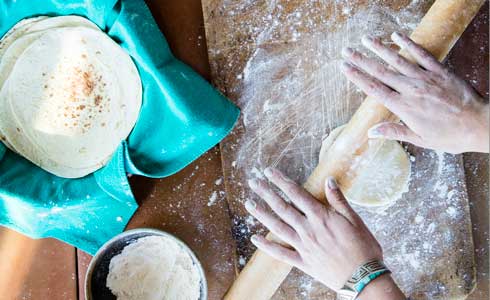
You can roll out tortillas with a pin, but when it comes to corn tortillas,
a press makes mass production easier. Photography by Jen Judge.
Flour Tortillas
Makes about 8 tortillas, approximately 7 to 8 inches in diameter
In Southwest culinary circles, flour tortillas are most closely associated with the cooking of Arizona and the Mexican state of Sonora. New Mexican versions—thicker, smaller in diameter, and chewier than most others— actually probably predate these better-known cousins. Spanish settlers preferred wheat to corn, so they used it to produce a flatbread similar to a Pueblo tortilla, a tradition that has persisted in Hispano families for centuries now. Cheryl Alters Jamison’s Little Sister in the Big Brothers Big Sisters program, Lenore Tapia-Baker, with other members of the Tapia family, taught her how to make these 30 years ago. Experienced practitioners can flap and slap and pull the dough out into perfect rounds, but for the rest of us it’s usually easier to roll them out with a pin or use a press.
- 2 cups low-gluten pastry or biscuit flour, or all-purpose flour
- 1 1⁄2 teaspoons baking powder (reduce by 1⁄4 teaspoon at altitudes above 5,000 feet)
- 1 teaspoon salt
- 1 tablespoon lard, vegetable shortening, or vegetable oil
- 3⁄4 cup lukewarm water
- unsalted butter or your favorite salsa
- Sift together into a large bowl the flour, baking powder, and salt. Work in the lard with your fingers. Add the water, working it quickly until a sticky dough forms.
- Knead the dough vigorously on a floured board for 1 minute. The mixture should no longer be sticky. This will sound a little odd, but if the dough is the same softness as your earlobe, it’s ready. If it remains more firm, knead a few more strokes until it’s earlobe soft. Cover the dough with a damp, clean dish towel and let it rest for about 15 minutes.
- Divide the dough into 8 equal pieces and form into balls. Cover the balls again with the damp towel and let them rest for another 15 to 30 minutes. (The dough can be refrigerated at this stage and kept for up to 4 hours. Bring the dough back to room temperature before proceeding.)
- On a floured surface, roll out each dough ball, from the center, into a disc no thicker than 1⁄4 inch. Turn the dough a quarter turn after each roll, to help shape the tortilla as you go. Trim off any ragged edges and discard them.
- Line a basket or plate just larger than the tortillas with a cloth napkin or several layers of paper napkins. Warm a dry griddle or large cast-iron skillet over high heat. Cook the tortillas 30 seconds on each side, until the dough looks dry, slightly leathery, and speckled brown in a few spots. Place each tortilla immediately in the basket as it is cooked. Savor the tortillas warm, with butter or salsa, or reserve for another use.
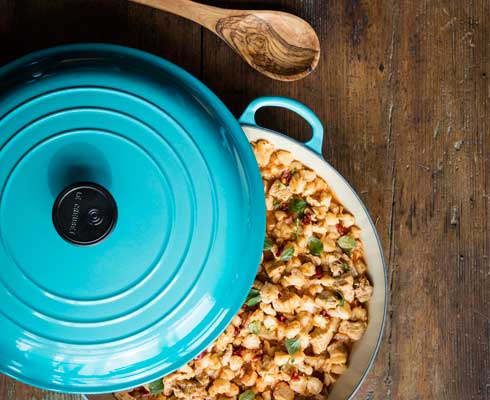
Posole, often served as a side dish, is hearty enough for the main course. Photography by Jen Judge.
Posole
Serves 8 or more
As one of the trinity of special summer crops, corn is occasionally eaten in New Mexico in ways familiar to other Americans, such as roasted or grilled on the cob, or made into a summer pudding, or simply cooked as a side dish of buttered kernels. The characteristically local ways of preparing corn, however, start with converting it to a preserved form. Turning it into posole is the most common method. The corn is nixtamalized (treated with slaked lime) to remove its outer skin, a technique developed by Native Americans centuries ago. The corn puffs up and becomes somewhat slicker in texture, with a distinctive bite when cooked. The technique also makes available the vitamins and an essential amino acid in the plant. A similar process produces hominy, but the lime compound is somewhat different and doesn’t result in the same earthiness found in posole.
- 6 dried New Mexican red chile pods, stemmed and seeded
- 1 to 1 1⁄2 pounds pork shoulder or loin, trimmed of surface fat and cut into bite-size cubes, or 1 or 2 pigs’ feet
- 2 pounds frozen posole or 1 pound dried posole
- 2 medium onions, chopped 6 to 10 garlic cloves, minced
- 1 tablespoon plus 1 teaspoon salt, or more to taste
- If you will be using frozen posole, first combine the chile pods with the pork in a Dutch oven or large pot and simmer in 4 quarts of water for about 30 minutes. Then add the frozen posole and cook about 30 minutes more. If your posole is dried, add it with the chile, pork, and 6 quarts of water and simmer for about 1 hour.
- Stir in the onions, garlic, and salt and continue to simmer over a low fire until the posole is soft. Expect the remaining cooking to take another 30 minutes for frozen posole and at least 1 hour if dried. Do not be surprised if it takes a bit longer.
- Serve hot in bowls with some of the liquid, or drain it with a slotted spoon and serve it on the side with other plated foods.
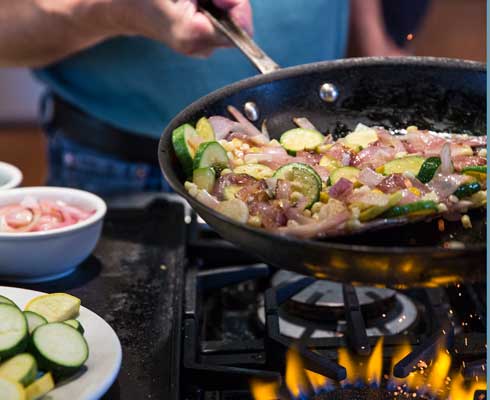
Calabacitas is a summertime staple. Photography by Jen Judge.
Calabacitas
Serves 6
In high summer in New Mexico, people eat this sauté by the bowlful. The preparation for calabacitas is fast, easy, and forgiving of additions and subtractions of ingredients.Just don’t rush the cooking, because the squash should be quite tender when done.
• 2 tablespoons butter
• 2 tablespoons vegetable oil
• 2 pounds mixed summer squash (such as yellow crookneck or gold bar squash, small zucchini, or light-green-skinned calabacita), sliced thin or in bite-size cubes
• 1 medium onion, chopped
• 2 small tomatoes, preferably roma or Italian plum, optional
• 2 cups corn kernels, fresh or frozen
• 1⁄4 to 3⁄4 cup chopped, roasted mild New Mexican green chile, fresh or thawed frozen
• 1⁄2 teaspoon salt
• up to 1⁄4 cup half-and-half, optional
• 4 ounces (1 cup) shredded Monterey Jack or cheddar cheese, optional
- Warm the butter and oil in a large skillet over medium heat. Add the squash, onion, and optional tomatoes. Sauté for 10 to 15 minutes, until the squash is well softened. Stir in the corn, chiles, and salt, and cook covered for another 10 minutes until all vegetables are tender. Pour in the half-and-half if you wish, and simmer briefly, until the liquid is reduced by about half.
- Serve hot. If using the cheese, scatter it over the calabacitas just before serving.
Variations: In Philomena Romero’s New Mexican Dishes (1970) she suggests the option of 1 sprig fresh cilantro. In a version from the Los Alamos Historical Society cookbook Savoring the Past (2001), San Ildefonso cook and potter Dora Tse-Pe sautéed pork sausage with the squash and then baked the mixture all together briefly before serving. The owners of Dick’s Café in Las Cruces, the Perez family, make a very saucy version of calabacitas, rich with tomatoes, tomato sauce, and a heavier topping of cheese. Antoinette Gonzales Knight, whose parents founded Mary & Tito’s in Albuquerque in the 1960s, says her dad liked to add ground sirloin. We’ve seen embellishments of carrots and chicos, substitutions of goat cheese for the cheddar or Monterey Jack, olive oil as the cooking fat, and additions such as garlic, cinnamon, and fresh mint.
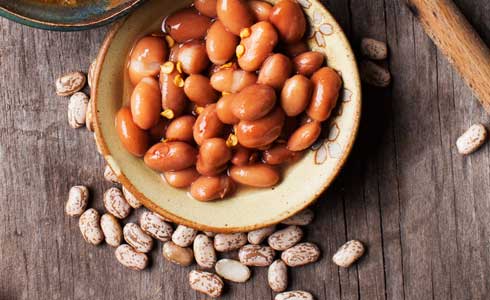
Frijoles de Olla. Photography by Inga Hendrickson.
Frijoles de Olla
Serves 6 to 8
Bolitos, Anasazis, favas—any of these beans can be simmered simply in salted water with tasty results. For pintos, which reign supreme, we suggest using the seasoning combination favored by Noe Cano, the longtime chef de cuisine at the Santa Fe School of Cooking.
- 2 cups dried pinto beans
- 8 cups water, or more as needed 1 head of garlic, minced
- 2 dried chipotle chiles
- 2 teaspoons dried epazote or 1 tablespoon minced fresh epazote, optional
- 1 1⁄2 teaspoons salt, or more to taste
- Pick through the beans and rinse them, discarding any gravel or grit.
- Place the beans in a stockpot or large, heavy saucepan. Cover them with water and add the garlic, chipotles, and optional epazote.
- Bring the beans just to a boil over high heat, then reduce the heat to low and simmer the beans uncovered. Plan on a total cooking time of 2 to 2 1⁄4 hours. After 1 hour, stir the beans up from the bottom and check the water level. If there is not at least an inch more water than beans, add enough hot water to bring it up to that level. Check the beans after another 30 minutes, repeating the process. Add the salt after the beans are well softened, and continue simmering. Check every 15 minutes, keeping the level of the water just above the beans. There should be extra liquid at the completion of the cooking time, but the beans should not be watery. If you wish, remove 1⁄2 to 1 cup of the beans, mash them, and return them to the pot for a thicker liquid.
- Serve warm. The beans keep several days, and are even better reheated.


